《市场营销学》课程授课教案(双语)Chapter 9 Pricing and Pricing Strategies
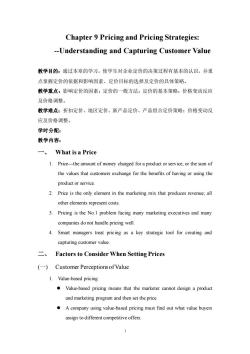
Chapter 9 Pricing and Pricing Strategies: -Understanding and Capturing Customer Value 教学目的:通过本章的学习,使学生对企业定价的决策过程有基本的认识,并重 点掌握定价的依据和影响因素、定价目标的选择及定价的具体策略。 教学重点:影响定价的因素:定价的一般方法:定价的基本策略;价格变动反应 及价格调整 教学难点:折扣定价、地区定价、新产品定价、产品组合定价策略:价格变动反 应及价格调整。 学时分配: 教学内容: 一、What is a Price 1.Price-the amount of money charged for a product or service.or the sum of the values that customers exchange for the benefits of having or using the product or service 2.Price is the only element in the marketing mix that produces revenue;all other elements represent costs. 3.Pricing is the No.I problem facing many marketing executives and many companies do not handle pricing well. 4.Smart managers treat pricing as a key strategic tool for creating and capturing customer value 二、 Factors to Consider When Setting Prices (-)Customer Perceptions of Value 1.Value-based pricing Value-based pricing means that the marketer cannot design a product and marketing program and then set the price. A company using value-based pricing must find out what value buyers assign to different competitive offers
1 Chapter 9 Pricing and Pricing Strategies: -Understanding and Capturing Customer Value 教学目的:通过本章的学习,使学生对企业定价的决策过程有基本的认识,并重 点掌握定价的依据和影响因素、定价目标的选择及定价的具体策略。 教学重点:影响定价的因素;定价的一般方法;定价的基本策略;价格变动反应 及价格调整。 教学难点:折扣定价、地区定价、新产品定价、产品组合定价策略;价格变动反 应及价格调整。 学时分配: 教学内容: 一、 What is a Price 1. Price—the amount of money charged for a product or service, or the sum of the values that customers exchange for the benefits of having or using the product or service. 2. Price is the only element in the marketing mix that produces revenue; all other elements represent costs. 3. Pricing is the No.1 problem facing many marketing executives and many companies do not handle pricing well. 4. Smart managers treat pricing as a key strategic tool for creating and capturing customer value. 二、 Factors to Consider When Setting Prices (一) Customer Perceptions of Value 1. Value-based pricing ⚫ Value-based pricing means that the marketer cannot design a product and marketing program and then set the price. ⚫ A company using value-based pricing must find out what value buyers assign to different competitive offers
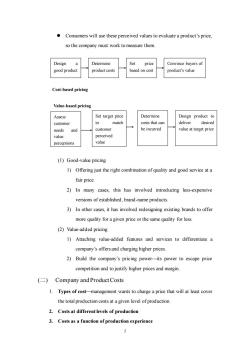
Consumers will use these perceived values to evaluate a product's price. so the company must work to measure them. Design Determine Set price Convince buyers of good produc product costs based on co product's value Cost-based pricing Value-based pricing Assess Set target pric Determine Design product to customer 0 matcl costs that can deliver desired customer be incurred value at target price perceptions (1)Good-value pricing 1)Offering just the right combination of quality and good service at a fair price. 2)In many cases,this has involved introducing less-expensive versions of established,brand-name products 3)In other cases,it has involved redesigning existing brands to offer more quality for a given price or the same quality for less. (2)Value-added pricing 1)Attaching value-added features and services to differentiate a company's offers and charging higher prices. 2)Build the company's pricing power-its power to escape price competition and tojustify higher prices and margin ()Company and Product Costs 1.Types of cost-management wants to charge a price that will at least cover the total production costs at a given level of production. 2.Costs at different levels of production 3.Costs as a function of production experience
2 ⚫ Consumers will use these perceived values to evaluate a product’s price, so the company must work to measure them. (1) Good-value pricing 1) Offering just the right combination of quality and good service at a fair price. 2) In many cases, this has involved introducing less-expensive versions of established, brand-name products. 3) In other cases, it has involved redesigning existing brands to offer more quality for a given price or the same quality for less. (2) Value-added pricing 1) Attaching value-added features and services to differentiate a company’s offers and charging higher prices. 2) Build the company’s pricing power—its power to escape price competition and to justify higher prices and margin. (二) Company and Product Costs 1. Types of cost—management wants to charge a price that will at least cover the total production costs at a given level of production. 2. Costs at different levels of production 3. Costs as a function of production experience Design a good product Determine product costs Set price based on cost Convince buyers of product’s value Cost-based pricing Assess customer needs and value perceptions Set target price to match customer perceived value Determine costs that can be incurred Design product to deliver desired value at target price Value-based pricing

(1)If a downward-sloping experience curve exists,this is highly significant for the company. (2)Experience-curve pricing carries risks: 1)The aggressive pricing might give the product a cheap image 2)The strategy also assumes that competitors are weak and not willing to fight it out by meeting the company's price cuts. 3)While the company is building volume under one technology,a competitor may find a lower-cost technology that lets it start at prices lower than those of the market leader,who still operates on the old experience curve 4.Cost-plus pricing (1)Reasons of being popular 1)Certainty About Costs: 2)Pricing is Simplified: 3)Price Competition Is Minimized 4)Much Fairer to Buyers&Sellers (2)Ignores demand and competitor prices 5.Break-even analysis and target profit pricing The manufacturer should consider different prices and estimate bread-even volumes,probable demand,and profits for each. ()Other Internal and External Considerations Affecting Price Decisions 1.Overall marketing strategy,objectives and mix (1)Marketing Objectives 1)Survival:Low Prices to Cover Variable Costs and Some Fixed Costs to Stay in Business. 2)Current Profit Maximization:Choose the Price that Produces the Maximum Current Profit,Etc 3)Market Share Leadership:Low as Possible Prices to Become the 3
3 (1) If a downward-sloping experience curve exists, this is highly significant for the company. (2) Experience-curve pricing carries risks: 1) The aggressive pricing might give the product a cheap image. 2) The strategy also assumes that competitors are weak and not willing to fight it out by meeting the company’s price cuts. 3) While the company is building volume under one technology, a competitor may find a lower-cost technology that lets it start at prices lower than those of the market leader, who still operates on the old experience curve. 4. Cost-plus pricing (1) Reasons of being popular 1) Certainty About Costs; 2) Pricing is Simplified; 3) Price Competition Is Minimized; 4) Much Fairer to Buyers & Sellers (2) Ignores demand and competitor prices 5. Break-even analysis and target profit pricing The manufacturer should consider different prices and estimate bread-even volumes, probable demand, and profits for each. (三) Other Internal and External Considerations Affecting Price Decisions 1. Overall marketing strategy, objectives and mix (1) Marketing Objectives 1) Survival:Low Prices to Cover Variable Costs and Some Fixed Costs to Stay in Business. 2) Current Profit Maximization:Choose the Price that Produces the Maximum Current Profit, Etc. 3) Market Share Leadership:Low as Possible Prices to Become the
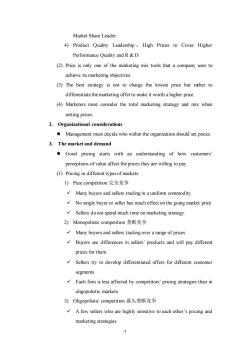
Market Share Leader. 4)Product Quality Leadership:High Prices to Cover Higher Performance Quality and R&D. (2)Price is only one of the marketing mix tools that a company uses to achieve its marketing objectives. (3)The best strategy is not to charge the lowest price but rather to differentiate the marketing offer to make it worth a higher price (4)Marketers must consider the total marketing strategy and mix when setting prices 2.Organizational considerations Management must decide who within the organization should set prices. 3.The market and demand Good pricing starts with an understanding of how customers perceptions of value affect the prices they are willing to pay (1)Pricing in different types of markets 1)Pure competition完全竞争 Many buyers and sellers trading in a uniform commodity No single buyer or seller has much effect on the going market price Sellers donot spend much time on marketing strategy. 2)Monopolistic competition垄断竞争 Many buyers and sellers tradingover a range of prices Buyers see differences in sellers'products and will pay different prices for them Sellers try to develop differentiated offers for different customer segments Each firm is less affected by competitors'pricing strategies than in oligopolistic markets. 3)Oligopolistic competition寡头垄断竞争 A few sellers who are highly sensitive to each other's pricing and marketing strategies
4 Market Share Leader. 4) Product Quality Leadership : High Prices to Cover Higher Performance Quality and R & D. (2) Price is only one of the marketing mix tools that a company uses to achieve its marketing objectives. (3) The best strategy is not to charge the lowest price but rather to differentiate the marketing offer to make it worth a higher price. (4) Marketers must consider the total marketing strategy and mix when setting prices. 2. Organizational considerations ⚫ Management must decide who within the organization should set prices. 3. The market and demand ⚫ Good pricing starts with an understanding of how customers’ perceptions of value affect the prices they are willing to pay. (1) Pricing in different types of markets 1) Pure competition 完全竞争 ✓ Many buyers and sellers trading in a uniform commodity ✓ No single buyer or seller has much effect on the going market price ✓ Sellers do not spend much time on marketing strategy. 2) Monopolistic competition 垄断竞争 ✓ Many buyers and sellers trading over a range of prices ✓ Buyers see differences in sellers’ products and will pay different prices for them ✓ Sellers try to develop differentiated offers for different customer segments ✓ Each firm is less affected by competitors’ pricing strategies than in oligopolistic markets. 3) Oligopolistic competition 寡头垄断竞争 ✓ A few sellers who are highly sensitive to each other’s pricing and marketing strategies
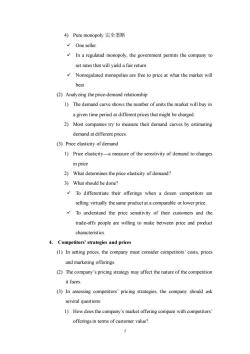
4)Pure monopoly完全垄断 √One seller. In a regulated monopoly,the government permits the company to set rates that will yield a fair retur Nonregulated monopolies are free to price at what the market will bear (2)Analyzing the price-demand relationship 1)The demand curve shows the number of units the market will buy in a given time period at different prices that might be charged. 2)Most companies try to measure their demand curves by estimating demand at different prices (3)Price elasticity of demand 1)Price elasticity-a measure of the sensitivity of demand to changes in price 2)What determines the price elasticity of demand? 3)What should be done? To differentiate their offerings when a dozen competitors are selling virtually the same product at a comparable or lower price. To understand the price sensitivity of their customers and the trade-offs people are willing to make between price and product characteristics 4.Competitors'strategies and prices (1)In setting prices,the company must consider competitors'costs,prices and marketing offerings. (2)The company's pricing strategy may affect the nature of the competition it faces. (3)In assessing competitors'pricing strategies,the company should ask several questions: 1)How does the company's market offering compare with competitors offerings in terms of customer value?
5 4) Pure monopoly 完全垄断 ✓ One seller. ✓ In a regulated monopoly, the government permits the company to set rates that will yield a fair return ✓ Nonregulated monopolies are free to price at what the market will bear (2) Analyzing the price-demand relationship 1) The demand curve shows the number of units the market will buy in a given time period at different prices that might be charged. 2) Most companies try to measure their demand curves by estimating demand at different prices. (3) Price elasticity of demand 1) Price elasticity—a measure of the sensitivity of demand to changes in price 2) What determines the price elasticity of demand? 3) What should be done? ✓ To differentiate their offerings when a dozen competitors are selling virtually the same product at a comparable or lower price. ✓ To understand the price sensitivity of their customers and the trade-offs people are willing to make between price and product characteristics. 4. Competitors’ strategies and prices (1) In setting prices, the company must consider competitors’ costs, prices and marketing offerings. (2) The company’s pricing strategy may affect the nature of the competition it faces. (3) In assessing competitors’ pricing strategies, the company should ask several questions: 1) How does the company’s market offering compare with competitors’ offerings in terms of customer value?
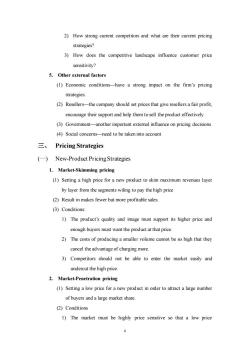
2)How strong current competitors and what are their current pricing strategies? 3)How does the competitive landscape influence customer price sensitivity? 5.Other external factors (1)Economic conditions-have a strong impact on the firm's pricing strategies (2)Resellers-the company should set prices that give resellers a fair profit, encourage their support and help them to sell the product effectively. (3)Govemment-another important external influence on pricing decisions (4)Social concemns-need to be taken into account 三、 Pricing Strategies (-)New-Product Pricing Strategies 1.Market-Skimming pricing (1)Setting a high price for a new product to skim maximum revenues layer by layer from the segments wiling to pay the high price (2)Result in makes fewer but more profitable sales. (3)Conditions: 1)The product's quality and image must support its higher price and enough buyers must want the product at that price 2)The costs of producing a smaller volume cannot be so high that they cancel the advantage of charging more. 3)Competitors should not be able to enter the market easily and undercut the high price 2.Market-Penetration pricing (1)Setting a low price for a new product in order to attract a large number of buyers and a large market share. (2)Conditions 1)The market must be highly price sensitive so that a low price 6
6 2) How strong current competitors and what are their current pricing strategies? 3) How does the competitive landscape influence customer price sensitivity? 5. Other external factors (1) Economic conditions—have a strong impact on the firm’s pricing strategies. (2) Resellers—the company should set prices that give resellers a fair profit, encourage their support and help them to sell the product effectively. (3) Government—another important external influence on pricing decisions (4) Social concerns—need to be taken into account 三、 Pricing Strategies (一) New-Product Pricing Strategies 1. Market-Skimming pricing (1) Setting a high price for a new product to skim maximum revenues layer by layer from the segments wiling to pay the high price (2) Result in makes fewer but more profitable sales. (3) Conditions: 1) The product’s quality and image must support its higher price and enough buyers must want the product at that price. 2) The costs of producing a smaller volume cannot be so high that they cancel the advantage of charging more. 3) Competitors should not be able to enter the market easily and undercut the high price. 2. Market-Penetration pricing (1) Setting a low price for a new product in order to attract a large number of buyers and a large market share. (2) Conditions 1) The market must be highly price sensitive so that a low price
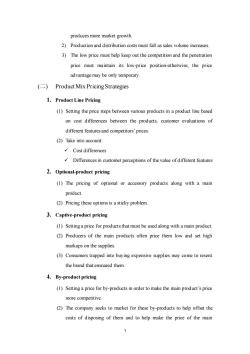
produces more market growth. 2)Production and distribution costs must fall as sales volume increases. 3)The low price must help keep out the competition and the penetration price must maintain its low-price position-otherwise,the price advantage may be only temporary. ()Product Mix PricingStrategies 1.Produet Line Pricing (1)Setting the price steps between various products in a product line based on cost differences between the products,customer evaluations of different features and competitors'prices (2)Take into account: V√Cost differences Differences in customer perceptions of the value of different features 2.Optional-product pricing (1)The pricing of optional or accessory products along with a main (2)Pricing these options is asticky problem 3.Captive-product pricing (1)Setting a price for products that must be used along with a main product. (2)Producers of the main products often price them low and set high markups on the supplies. (3)Consumers trapped into buying expensive supplies may come to resent the brand that ensnared them. 4.By-product pricing (1)Setting a price for by-products in order to make the main product's price more competitive. (2)The company seeks to market for these by-products to help offset the costs of disposing of them and to help make the price of the main >
7 produces more market growth. 2) Production and distribution costs must fall as sales volume increases. 3) The low price must help keep out the competition and the penetration price must maintain its low-price position-otherwise, the price advantage may be only temporary. (二) Product Mix Pricing Strategies 1. Product Line Pricing (1) Setting the price steps between various products in a product line based on cost differences between the products, customer evaluations of different features and competitors’ prices. (2) Take into account: ✓ Cost differences ✓ Differences in customer perceptions of the value of different features 2. Optional-product pricing (1) The pricing of optional or accessory products along with a main product. (2) Pricing these options is a sticky problem. 3. Captive-product pricing (1) Setting a price for products that must be used along with a main product. (2) Producers of the main products often price them low and set high markups on the supplies. (3) Consumers trapped into buying expensive supplies may come to resent the brand that ensnared them. 4. By-product pricing (1) Setting a price for by-products in order to make the main product’s price more competitive. (2) The company seeks to market for these by-products to help offset the costs of disposing of them and to help make the price of the main
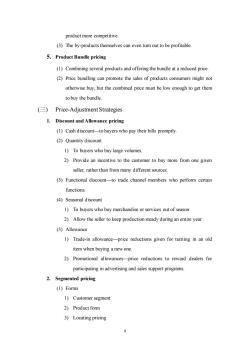
product more competitive. (3)The by-products themselves can even turn out to be profitable. 5.Product Bundle pricing (1)Combining several products and offering the bundle at a reduced price. (2)Price bundling can promote the sales of products consumers might not otherwise buy,but the combined price must be low enough to get them to buy the bundle ()Price-Adjustment Strategies 1.Discount and Allowance pricing (1)Cash discount-to buyers who pay their bills promptly (2)Quantity discount 1)To buyers who buy large volumes. 2)Provide an incentive to the customer to buy more from one given seller,rather than from many different sources (3)Functional discount-to trade channel members who perform certain functions (4)Seasonal discount 1)To buyers who buy merchandise or services out of season 2)Allow the seller to keep production steady during an entire year (5)Allowance 1)Trade-in allowance-price reductions given for tuming in an old item when buying a new one. 2)Promotional allowances-price reductions to reward dealers for participating in advertising and sales support programs 2.Segmented pricing (1)Forms 1)Customer segment 2)Product form 3)Locating pricing
8 product more competitive. (3) The by-products themselves can even turn out to be profitable. 5. Product Bundle pricing (1) Combining several products and offering the bundle at a reduced price. (2) Price bundling can promote the sales of products consumers might not otherwise buy, but the combined price must be low enough to get them to buy the bundle. (三) Price-Adjustment Strategies 1. Discount and Allowance pricing (1) Cash discount—to buyers who pay their bills promptly. (2) Quantity discount 1) To buyers who buy large volumes. 2) Provide an incentive to the customer to buy more from one given seller, rather than from many different sources. (3) Functional discount—to trade channel members who perform certain functions. (4) Seasonal discount 1) To buyers who buy merchandise or services out of season 2) Allow the seller to keep production steady during an entire year (5) Allowance 1) Trade-in allowance—price reductions given for turning in an old item when buying a new one. 2) Promotional allowances—price reductions to reward dealers for participating in advertising and sales support programs. 2. Segmented pricing (1) Forms 1) Customer segment 2) Product form 3) Locating pricing
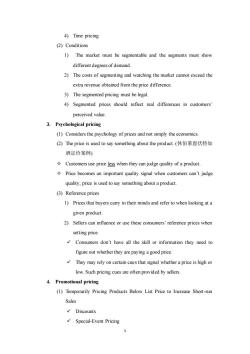
4)Time pricing (2)Conditions 1)The market must be segmentable and the segments must show different degreesof demand 2)The costs of segmenting and watching the market cannot exceed the extra revenue obtained from the price difference. 3)The segmented pricing must be legal 4)Segmented prices should reflect real differences in customers perceived value. 3.Psychological pricing (1)Considers the psychology of prices and not simply the economics (2)The price is used to say something about the product.(休伯莱恩伏特加 酒定价案例) Customers use price less when they can judge quality of a product Price becomes an important quality signal when customers can't judge quality:price is used to say something about a product (3)Reference prices 1)Prices that buyers carry in their minds and refer to when looking at a given product. 2)Sellers can influence or use these consumers'reference prices when setting price Consumers don't have all the skill or information they need to figure out whether they are paying a good price. They may rely on certain cues that signal whether a price is high or low.Such pricing cues are often provided by sellers 4.Promotional pricing (1)Temporarily Pricing Products Below List Price to Increase Short-run Sales √Discounts Special-Event Pricing 9
9 4) Time pricing (2) Conditions 1) The market must be segmentable and the segments must show different degrees of demand. 2) The costs of segmenting and watching the market cannot exceed the extra revenue obtained from the price difference. 3) The segmented pricing must be legal. 4) Segmented prices should reflect real differences in customers’ perceived value. 3. Psychological pricing (1) Considers the psychology of prices and not simply the economics. (2) The price is used to say something about the product. (休伯莱恩伏特加 酒定价案例) Customers use price less when they can judge quality of a product. Price becomes an important quality signal when customers can’t judge quality; price is used to say something about a product. (3) Reference prices 1) Prices that buyers carry in their minds and refer to when looking at a given product. 2) Sellers can influence or use these consumers’ reference prices when setting price. ✓ Consumers don’t have all the skill or information they need to figure out whether they are paying a good price. ✓ They may rely on certain cues that signal whether a price is high or low. Such pricing cues are often provided by sellers. 4. Promotional pricing (1) Temporarily Pricing Products Below List Price to Increase Short-run Sales ✓ Discounts ✓ Special-Event Pricing
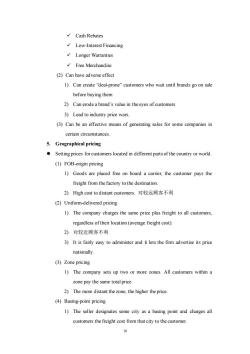
√Cash Rebates Low-Interest Financing √Longer Warranties Free Merchandise (2)Can have adverse effect 1)Can create"deal-prone"customers who wait until brands go on sale before buying them 2)Can erode a brand's value in the eyes of customers 3)Lead to industry price wars. (3)Can be an effective means of generating sales for some companies in certain circumstances 5.Geographical pricing Setting prices for customers located in different parts of the country or world. (1)FOB-origin pricing 1)Goods are placed free on board a carrier,the customer pays the freight from the factory to the destination. 2)High cost to distant customers.对较远顾客不利 (2)Uniform-delivered pricing 1)The company charges the same price plus freight to all customers, regardless oftheir location(average freight cost). 2)对较近顾客不利 3)It is fairly easy to administer and it lets the firm advertise its price nationally. (3)Zone pricing 1)The company sets up two or more zones.All customers within a zone pay the same total price 2)The more distant the zone,the higher the price. (4)Basing-point pricing 1)The seller designates some city as a basing point and charges all customers the freight cost from that city to the customer 6
10 ✓ Cash Rebates ✓ Low-Interest Financing ✓ Longer Warranties ✓ Free Merchandise (2) Can have adverse effect 1) Can create “deal-prone” customers who wait until brands go on sale before buying them 2) Can erode a brand’s value in the eyes of customers 3) Lead to industry price wars. (3) Can be an effective means of generating sales for some companies in certain circumstances. 5. Geographical pricing ⚫ Setting prices for customers located in different parts of the country or world. (1) FOB-origin pricing 1) Goods are placed free on board a carrier, the customer pays the freight from the factory to the destination. 2) High cost to distant customers. 对较远顾客不利 (2) Uniform-delivered pricing 1) The company charges the same price plus freight to all customers, regardless of their location (average freight cost). 2) 对较近顾客不利 3) It is fairly easy to administer and it lets the firm advertise its price nationally. (3) Zone pricing 1) The company sets up two or more zones. All customers within a zone pay the same total price 2) The more distant the zone, the higher the price. (4) Basing-point pricing 1) The seller designates some city as a basing point and charges all customers the freight cost from that city to the customer
按次数下载不扣除下载券;
注册用户24小时内重复下载只扣除一次;
顺序:VIP每日次数-->可用次数-->下载券;
- 《市场营销学》课程授课教案(双语)Chapter 10 Marketing Channels.doc
- 内蒙古科技大学:《市场营销学》课程授课教案(中文)第1章 营销与营销过程.doc
- 内蒙古科技大学:《市场营销学》课程授课教案(中文)第3章 营销系统与营销环境分析.doc
- 内蒙古科技大学:《市场营销学》课程授课教案(中文)第4章 消费者市场与购买行为分析.doc
- 内蒙古科技大学:《市场营销学》课程授课教案(中文)第2章 顾客价值与顾客满意.doc
- 内蒙古科技大学:《市场营销学》课程授课教案(中文)第9章 市场传播与促销.doc
- 内蒙古科技大学:《市场营销学》课程授课教案(中文)第10章 产品生命周期与营销战略.doc
- 内蒙古科技大学:《市场营销学》课程授课教案(中文)第6章 产品决策.doc
- 内蒙古科技大学:《市场营销学》课程授课教案(中文)第5章 市场细分、决定目标市场与定位.doc
- 内蒙古科技大学:《市场营销学》课程授课教案(中文)第7章 价格策略.doc
- 内蒙古科技大学:《市场营销学》课程授课教案(中文)第8章 分销管理.doc
- 内蒙古科技大学:《市场营销学》课程教学资源(试卷习题)2013-2014第二学期试卷A(答案).doc
- 内蒙古科技大学:《市场营销学》课程教学资源(试卷习题)2013-2014第二学期试卷A(试题).doc
- 内蒙古科技大学:《市场营销学》课程教学资源(试卷习题)2012-2013第二学期试卷B(答案).doc
- 内蒙古科技大学:《市场营销学》课程教学资源(试卷习题)2012-2013第二学期试卷B(试题).doc
- 内蒙古科技大学:《市场营销学》课程教学资源(试卷习题)2012-2013第一学期试卷A(答案).doc
- 内蒙古科技大学:《市场营销学》课程教学资源(试卷习题)2012-2013第一学期试卷B(答案).doc
- 内蒙古科技大学:《市场营销学》课程教学资源(试卷习题)2012-2013第一学期试卷B(试题).doc
- 内蒙古科技大学:《市场营销学》课程教学资源(试卷习题)2012-2013第一学期试卷A(试题).doc
- 内蒙古科技大学:《市场营销学》课程教学资源(试卷习题)2011-2012第二学期试卷A(答案).doc
- 《市场营销学》课程授课教案(双语)Chapter 6 Business Markets and Business Buyer Behavior.doc
- 《市场营销学》课程授课教案(双语)Chapter 7 Customer-Driven Marketing Strategy.doc
- 《市场营销学》课程授课教案(双语)Chapter 8 Products, Services, and Brands.doc
- 《市场营销学》课程授课教案(双语)Chapter 11 Communicating Customer Value.doc
- 《市场营销学》课程授课教案(双语)Chapter 2 Company and Marketing Strategy.doc
- 《市场营销学》课程授课教案(双语)Chapter 4 Managing Marketing Information to Gain Customer Insights.doc
- 《市场营销学》课程授课教案(双语)Chapter 5 Consumer Markets and Consumer Buyer Behavior.doc
- 《市场营销学》课程授课教案(双语)Chapter 3 Analyzing the Marketing Environment.doc
- 《市场营销学》课程授课教案(双语)Chapter 1 Marketing.doc
- 《市场营销学》课程教学案例(中文)第8章案例 分销渠道策略-通用公司打造全球供应链.doc
- 《市场营销学》课程教学案例(中文)第9章案例 促销策略-中国肥皂泡戏煞东瀛人.doc
- 《市场营销学》课程教学案例(中文)第6章案例 产品决策-广东太阳神的产品组合.doc
- 《市场营销学》课程教学案例(中文)第7章案例 价格决策-海信空调的价格策略.doc
- 《市场营销学》课程教学案例(中文)第5章案例 市场细分、决定目标市场与定位- “红高粱”的启示.doc
- 《市场营销学》课程教学案例(中文)第3章案例 市场营销环境-恒伟药业信息调研出效益.doc
- 《市场营销学》课程教学案例(中文)第4章案例 分析消费者市场与购买行为-小阿华的“精确营销”.doc
- 《市场营销学》课程教学案例(中文)第2章案例 规划企业战略与市场营销管理-雅戈尔,选择没有对错.doc
- 《市场营销学》课程教学案例(中文)第1章案例 营销与营销管理-亚马逊名震全球之道.doc
- 《市场营销学》课程教学案例(双语)The Pepsi and Coca-Cola Challenge-A Cola with Breakfast.doc
- 《市场营销学》课程教学案例(双语)Van Der Steen Candy Company.doc
